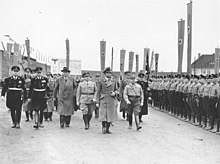geo.wikisort.org - River
The Mittelland Canal, also known as the Midland Canal, (German: Mittellandkanal, German: [ˈmɪtl̩.lant.kaˌnaːl] (![]() listen)) is a major canal in central Germany. It forms an important link in the waterway network of that country, providing the principal east-west inland waterway connection. Its significance goes beyond Germany as it links France, Switzerland and the Benelux countries with Poland, the Czech Republic and the Baltic Sea.[1]
listen)) is a major canal in central Germany. It forms an important link in the waterway network of that country, providing the principal east-west inland waterway connection. Its significance goes beyond Germany as it links France, Switzerland and the Benelux countries with Poland, the Czech Republic and the Baltic Sea.[1]
| Mittelland Canal | |
|---|---|
 Course of the Mittelland Canal | |
| Specifications | |
| Length | 325.7 km (202 mi) |
| History | |
| Construction began | 1906 |
| Date completed | 1938 |
| Geography | |
| Start point | Dortmund-Ems Canal at Hörstel (near Rheine, Germany |
| End point | Elbe River and Elbe-Havel Canal near Magdeburg, Germany |
| Beginning coordinates | 52°16′37″N 7°36′18″E |
| Ending coordinates | 52°14′46″N 11°44′49″E |
At 325.7 kilometres (202.4 mi) in length,[2] the Mittelland Canal is the longest artificial waterway in Germany.
Route
The Mittelland Canal branches off the Dortmund-Ems Canal[2] at Hörstel (near Rheine, at 52°16′37″N 7°36′18″E), runs north along the Teutoburg Forest, past Hanover and meets with the Elbe River near Magdeburg (52°14′46″N 11°44′49″E). Near Magdeburg it connects to the Elbe-Havel Canal,[2] making a continuous shipping route to Berlin and on to Poland.[1]
At Minden the canal crosses the river Weser over two aqueducts (completed in 1914 and 1998, respectively), and near Magdeburg it crosses the Elbe, also with an aqueduct. Connections by side canals exist at Ibbenbüren, Osnabrück, Minden (two canals connecting to the Weser), Hanover-Linden, Hanover-Misburg, Hildesheim and Salzgitter.[2] West of Wolfsburg, the Elbe Lateral Canal branches off, providing a connection to Hamburg, and (via the Elbe-Lübeck Canal) to the Baltic Sea.
History

Construction of the Mittelland Canal was started in 1906, starting from Bergeshövede (municipality Hörstel) on the Dortmund-Ems Canal. The section to Minden on the Weser was opened in February 1915 and was initially named Ems-Weser-Kanal. The section from Minden to Hanover was finished in the autumn of 1916. The section to Sehnde and the branch canal to Hildesheim were completed in 1928, Peine was reached in 1929, and Braunschweig in 1933. The final section to Magdeburg was opened in 1938, thus creating a direct link between Western and Eastern Germany. The branch canal to Salzgitter was opened in 1941. The planned canal bridge over the Elbe, necessary to avoid low water conditions in summer, was not built due to the Second World War.[3]
After partitioning of Germany following the Second World War, the Mittelland Canal was split between West Germany and East Germany, with the border to the east of Wolfsburg. To provide access from the western section of the canal to Hamburg and Northern Germany, avoiding both East Germany and the Elbe River's sometimes limited navigability, the Elbe Lateral Canal was opened in 1977.
After the reunification of Germany, the importance of the Mittelland Canal as a link from the west to Berlin and the east was reinforced. The project to bridge the Elbe was therefore restarted, and the resulting Magdeburg Water Bridge opened in 2003, providing a direct link to the Elbe-Havel Canal. There are further plans to connect the channel to the Twentekanaal in the Netherlands to shorten the connection towards the Port of Rotterdam.[4]
Towns and cities
- Ibbenbüren
- Osnabrück (via a branch)
- Bramsche
- Lübbecke
- Minden
- Garbsen
- Hannover
- Sehnde
- Hildesheim (via a branch)
- Peine
- Salzgitter (via a branch)
- Braunschweig
- Wolfsburg
- Haldensleben
- Magdeburg

Structures
- Minden Aqueduct (52°18′12″N 8°55′54″E)
- Magdeburg Water Bridge (52°13′51″N 11°42′5″E)
Gallery
- Old and new Mittelland Canal aqueducts near Minden
- Aerial view of aqueducts and River Weser
- The canal near Minden
- Mittelland Canal / River Weser Lock at Minden
- Part of the original Volkswagen plant on the canal
References
- Sheffield, Barry (1995). Inland Waterways of Germany. St Ives: Imray Laurie Norie & Wilson. ISBN 0-85288-283-1.
- Elwis database WSD Mitte Archived 2010-10-28 at the Wayback Machine and WSD Ost Archived 2010-10-28 at the Wayback Machine
- Wasser- und Schifffahrtsamt Minden Archived 2013-01-06 at the Wayback Machine (in German)
- Euregio: „Verbindung zwischen Mittellandkanal und Twentekanal nicht wirtschaftlich“. Stand: 2013. http://www.euregio.eu/de/pressemitteilungen/verbindung-zwischen-mittellandkanal-und-twentekanal-nicht-wirtschaftlich (retrieved on October 2, 2014).
На других языках
[de] Mittellandkanal
Der Mittellandkanal (MLK) ist eine Bundeswasserstraße[2] und mit 325,3 Kilometern Länge die längste künstliche Wasserstraße in Deutschland. Inklusive Stich- und Verbindungskanälen beträgt die Länge 392 km. Er verbindet den Dortmund-Ems-Kanal mit Weser, Elbe und dem Elbe-Havel-Kanal. Im weiteren Sinne ist er Teil einer Verbindung zwischen Rhein und Oder. Im Westen wird die Verbindung zum Rhein über Dortmund-Ems-Kanal und Rhein-Herne-Kanal oder Wesel-Datteln-Kanal hergestellt. Im Osten verbinden Elbe-Havel-Kanal, Untere Havel-Wasserstraße und Havel-Oder-Wasserstraße den Mittellandkanal mit der Oder. In europäischer Dimension ermöglicht er eine Verbindung zwischen den Niederlanden, Belgien, Luxemburg, Frankreich und der Schweiz auf der einen und mit Polen und Tschechien auf der anderen Seite.- [en] Mittelland Canal
[it] Mittellandkanal
Il Mittellandkanal o Canale del Mittelland con i suoi 325,7 chilometri (392 includendo i canali di diramazione e quelli di collegamento) è il canale più lungo della Germania centrale. Costituisce una via d'acqua basilare nel Paese suddetto, congiungendo le regioni industriali dei Länder occidentali con le regioni agricole della Germania centro-orientale, inoltre collega gli Stati dell'Europa occidentale quali Francia, Svizzera e Benelux con quelli dell'Europa orientale come Polonia e Repubblica Ceca.[ru] Среднегерманский канал
Среднегерманский канал (нем. Mittellandkanal; также Везер-Эмс и Везер-Эльба) — самый длинный канал в Германии. Имеет длину 325 км[1].Другой контент может иметь иную лицензию. Перед использованием материалов сайта WikiSort.org внимательно изучите правила лицензирования конкретных элементов наполнения сайта.
WikiSort.org - проект по пересортировке и дополнению контента Википедии




